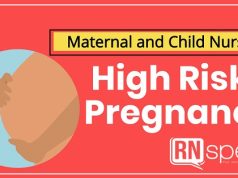During pregnancy, a woman may develop a slight expansion in the blood volume than the normal RBC count as the body prepares for catering to the growing fetus inside the mother’s womb. It is called pseudoanemia of early pregnancy- which is part of the normal changes in the woman’s body. True anemia, however, occurs as a complication of pregnancy.
According to Anderson & Anderson (1990), it can be classified as pathologic or physiologic. It can be considered as pathologic if it is because of a disorder in the production of erythrocytes or is there is excessive loss of erythrocytes due to bleeding or destructions. Meanwhile, it can be a physiologic type of anemia in pregnancy if the decline in production is due to hemodilution or when the plasma volume expands more than the RBC volume.
The most common anemia in pregnancy is called Iron deficiency anemia, which can be simply described as a condition which is presented with a decrease in hemoglobin and oxygen transport. Its etiology may vary but maybe sometimes due to an anemic state, heavy menstrual periods, and poor nutritional intake prior to pregnancy. It can be suspected when the hemoglobin level is below 11 mg/dl. Furthermore, it is characterized by a small-sized RBC and a reduced hemoglobin level than the average cell count. The mean corpuscular volume and the mean corpuscular hemoglobin are both observed to be low in this type of anemia. Thus, it is associated with low birth weight and premature delivery.
Megaloblastic anemia or folic acid deficiency is defined as a disorder in the RBC production in which the red cells fail to divide and become enlarged. Folic acid is very important in the synthesis of nucleic acid which is also required for the production of red blood cells. During pregnancy, a woman needed more folic acid than ever before. He MCV is, however, elevated compared to Iron deficiency anemia. Its complications may correspond to adverse defects in fetal development and also for early abortion and abruption placenta.
The third type of anemia during pregnancy is the sickle cell anemia. It is caused primarily of the Hemoglobin S causing other red blood cells to sickle or follows a crescent shape. Thus, it is considered as an autosomal recessive disorder. It does not influence the pregnancy itself but a woman with a sickle disease, pregnancy is considered the complication. The threat is directed to the growth and well being of the fetus since this disease usually results in clumping (due to increased tension to the cells) which in return causes some veno- occlusive crisis. The blockage in blood vessels especially to the placental circulation could lead to fetal compromise and worse to death.
Nursing considerations in general for pregnant clients with anemia include:
- Assessment of nutritional intake and status
- Assess for fatigue, pallor, sore tongue, anorexia, nausea and vomiting, stomatitis, some signs of infection, and severe pain (due to veno- occlusive crisis
- Observe and monitor hematologic laboratory results
- Encourage the client to eat foods high in iron and folic acids like green leafy vegetables, fish, meat, poultry, eggs, and legumes.
- Teach how to prepare food in order to minimize the loss of iron and folic acid (steaming with small amount of water)
- Encourage to take foods high in Vitamin C for iron absorption
- Emphasize diet high in fiber and fluids to avoid constipation (a side effect of iron intake)
- Emphasize also good hygiene to avoid urinary tract infection
- Also instruct the client to avoid people with infection, as they may be prone to acquire the infection, too.
- Teach the client to watch out for signs of preterm labor
- Observe and monitor the fetal well being
- Allow the client to rest as much as possible and provide emotional support








